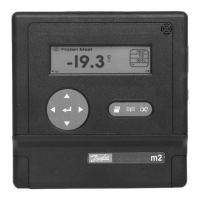26 Manual RS.8A.N5.02 © Danfoss 10-2007 m2 Version 3.11
Curve This eld is used to select 1 of the 4 curve tables
(Cf1 - Cf4).
Break This eld is used to select the break point being
set up on the curve (1 - 12).
Input This eld is for the Internally Scaled input value to
be used at the break point selected. The 'To use ='
value can be copied into this eld by pressing ' '
and ' ' together. This eld has a range of between
0 and 9999.
Output This eld is for the Output value at the Break Point/
Input value selected. This has a range of between
-999.9 and 999.9.
The table should be completed so that the Input readings increase in value. Any
reading below the rst value or above the last value will return out of range
Output Values (OC/SC).
In order to set up a Table you will require either a Resistance box (for resistance
probes) or a Current Source (for Current Probes) plus the manufacturer's data
dening the Input/Output relationship of the probe. The method is described
for a Resistance probe, but it is the same for the Current case except that it is
necessary to put the Input 1 link in the 4-20 mA position before starting.
1. Select (up to) 12 Output (Resistance) values from the
manufacturer's data sheet which correspond to Input (e.g.
Temperature) values in the range you wish to measure. For
maximum accuracy these points should be distributed evenly
across the required range.
2. Connect the Resistance Box across the Input No. 1 and C
terminals of the unit and set it to the lowest of your selected
Output values. When you do this you should see a value appear
in the 'To use =' eld. This is the Internally Scaled version of the
resistance you have connected. Set the Break eld to 1 and then
go to the Input eld.
3. Next either manually enter the value displayed in the 'To use ='
eld, or press the ‘ ‘ and ‘ ‘ keys together to copy it to the Input eld.
4. Move to the Output eld and enter the Output (e.g. Temperature) value
from your probe data corresponding to the Resistance value you set.
5. Move the Edit Box to the Break eld again and increase its value by 1,
which will clear the Input and Output elds.
6. Set your next chosen Resistance value from the probe data and,
when the 'To use =' value has stabilised, repeat from step 3
until all your points have been entered.
Once all points have been entered, you can vary the resistance connected to
Input 1 and observe the eect in the Converted eld. For a given resistance, this
value should now be the same as that shown in the manufacturer's probe data.
For 4-20 mA inputs the 'Input type' must be set to 'CURRENT', then the Input/
Output elds will change to 4 mA/20 mA. The curve table can now be set up.
For example, if a pressure sensor was being used which produced 4 mA at 0.1
bar and 20 mA at 30 bar, then simply add 0.1 to the 4 mA eld and 30 to the 20
mA led. Ensure the point set-up and jumper link on the input terminal is set to
4-20 mA.
When you have nished or to abandon the operation, press ‘ ’ to return to
the Setup Menu.
Setting up a Curve Table
4-20 mA Set-up

